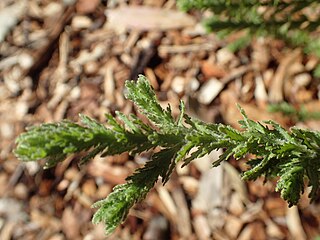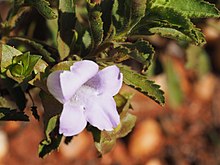Eremophila accrescens is a plant in the figwort family, Scrophulariaceae and is endemic to Western Australia where it usually grows in rocky places or near drainage channels. It is an erect shrub with greyish, slightly furry, variably-shaped leaves and white to pale blue or purple petals.
Eremophila appressa, commonly known as wispy poverty bush, is a plant in the figwort family, Scrophulariaceae and is endemic to two remote locations in the central west of Western Australia. Its most unusual feature is its leaves which, at least when young, are less than 2.5 mm (0.1 in) long and 1 mm (0.04 in) wide and are glued to the stem by resin.

Eremophila caespitosa, commonly known as felty-leaved eremophila, is a flowering plant in the figwort family, Scrophulariaceae and is endemic to an area near the centre of Western Australia. It is a small shrub with a tuft-like habit, very hairy grey leaves and lilac to purple flowers.
Eremophila coacta is a flowering plant in the figwort family, Scrophulariaceae and is endemic to a small area in the north west of Western Australia. It is an erect shrub with narrow, sticky, pointed leaves and densely hairy light to dark lilac-coloured flowers.

Eremophila demissa is a flowering plant in the figwort family, Scrophulariaceae and is endemic to a small area of central Western Australia. It is a low, spreading shrub with small, yellowish grey leaves and branches and mauve to blue flowers.

Eremophila enata is a flowering plant in the figwort family, Scrophulariaceae and is endemic to central areas of Western Australia. It is a low, spreading shrub with serrated leaves and purplish to pinkish flowers.

Eremophila flabellata is a flowering plant in the figwort family, Scrophulariaceae and is endemic to Western Australia. It is a small shrub with serrated leaves, broad serrated sepals and pink, purple or mauve flowers.

Eremophila incisa is a flowering plant in the figwort family, Scrophulariaceae and is endemic to Western Australia. It is a low shrub with shiny leaves which have thickened teeth along their edges and hairy, mauve or purple flowers.

Eremophila jucunda is a flowering plant in the figwort family, Scrophulariaceae and is endemic to Western Australia. It is a small to medium-sized shrub with hairy branches and leaves, lance-shaped to egg-shaped leaves and cream-coloured, lilac or purple flowers.
Eremophila lanata is a flowering plant in the figwort family, Scrophulariaceae and is endemic to Western Australia. It is a small shrub with small, hairy leaves, densely hairy sepals and lilac to pinkish flowers.

Eremophila lanceolata is a flowering plant in the figwort family, Scrophulariaceae and is endemic to Western Australia. It is a low, spreading shrub with foliage which is shiny when young, angular branches and lilac to purple flowers and which grows in the north-west of Western Australia.

Eremophila magnifica is a flowering plant in the figwort family, Scrophulariaceae and is endemic to Western Australia. It is an erect shrub with large, clustered leaves and large, attractive lilac-coloured or purple flowers, sometimes so densely clustered that they appear like compound heads of terminal flowers.
Eremophila obliquisepala is a flowering plant in the figwort family, Scrophulariaceae and is endemic to Western Australia. It is a small, compact shrub with serrated leave, blue to purple flowers and unusually-shaped sepals.

Eremophila phyllopoda is a flowering plant in the figwort family, Scrophulariaceae and is endemic to Western Australia. It is an erect or spreading shrub, sometimes round or flat-topped with sticky, hairy leaves and flowers ranging in colour from pink or lilac to purple.
Eremophila pilosa is a flowering plant in the figwort family, Scrophulariaceae and is endemic to Western Australia. It is a small shrub with many tangled branches, with its leaves and branches densely covered with hairs and which has mauve or purple flowers. It occurs in a restricted area in the Pilbara.

Eremophila pinnatifida, commonly known as Dalwallinu eremophila is a flowering plant in the figwort family, Scrophulariaceae and is endemic to Western Australia. It is a spreading, rounded shrub with aromatic, deeply divided leaves and pale purple flowers which are white with purple spots inside. It is a rare plant, known only from a few areas near Perth.
Eremophila pungens is a flowering plant in the figwort family, Scrophulariaceae and is endemic to Australia. It is an erect, sticky shrub with broad, serrated-edged leaves which end in a sharp spine and purple or violet flowers.
Eremophila retropila is a flowering plant in the figwort family, Scrophulariaceae and is endemic to Western Australia. It is an erect, spreading shrub with hairy, greyish leaves crowded at the ends of the branches, and lilac or violet-coloured flowers which are white inside.

Eremophila rigida is a flowering plant in the figwort family, Scrophulariaceae and is endemic to Western Australia. It is an erect, rigid shrub with thick, hairy, rigid leaves and pale yellowish-cream flowers.
Eremophila spongiocarpa is a flowering plant in the figwort family, Scrophulariaceae and is endemic to Western Australia. It is a compact shrub with many tangled branches, flattened, succulent leaves, hairy sepals and creamy white petals which are spotted red on the inside.












